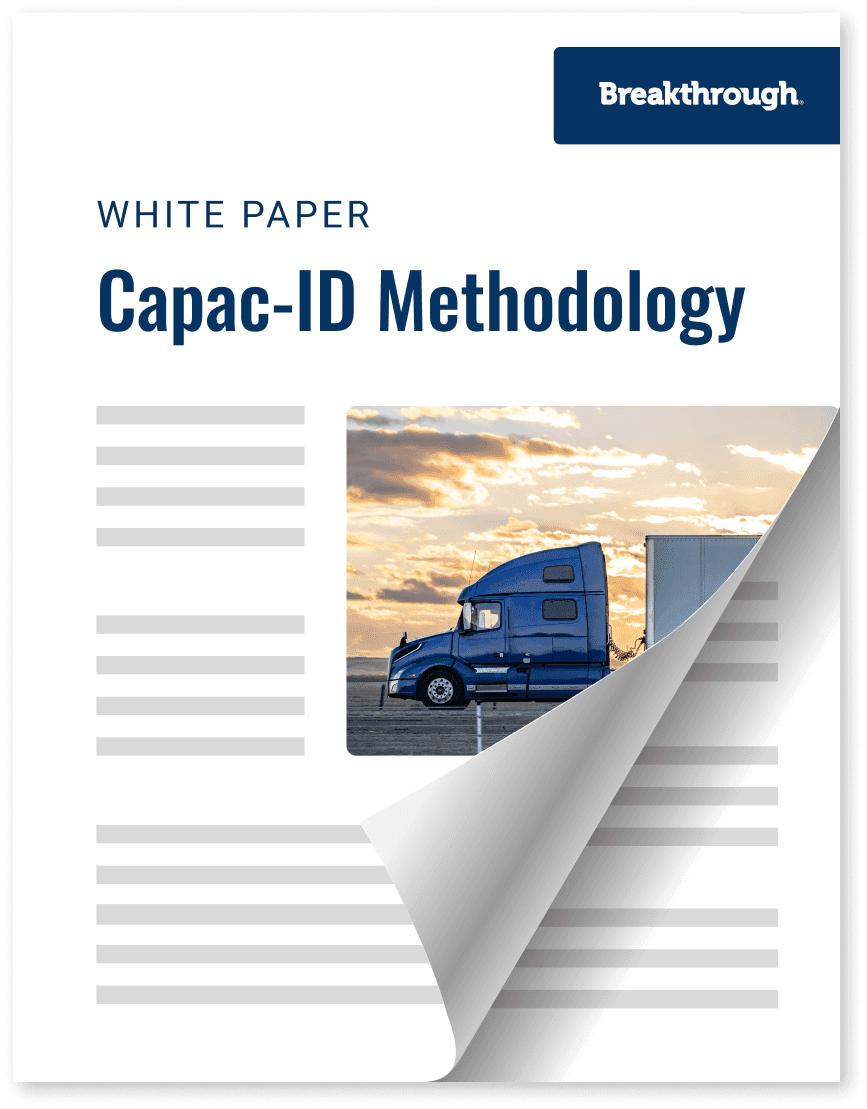Breakthrough’s Capac-ID Methodology

Trending
Top Posts
5 min read
August 26, 2019

Share:
Table of contents
Browse the table of contents to jump straight to the part you’re looking for
The reality of macro-level headlines is they often fail to drill into the regional nuances of the energy supply chain. This highlights the importance of understanding all the unique variables involved in determining regional diesel prices. When looking at these more detailed price factors, traditional relationships between local wholesale prices and the DOE Index become increasingly complex.
As a result, planning for fuel expenditures has become more difficult for both shippers and carriers. With increasingly volatile price behavior on a regional level, carriers operating on DOE-based fuel surcharges face price uncertainty in the planning process, reinforcing the value of utilizing market-based fuel management strategies.

The second trading region in our ongoing Spot Market Overview series is the US Gulf Coast (USGC) – the largest in the United States in terms of both size it encompasses and the infrastructure it houses. As mentioned in our recent blog discussing the diesel price impacts of hurricane season, the USGC is also the country’s most lucrative in terms of its fuel market influence. All states linked to the USGC are not exclusively associated with the region and may rely on neighboring markets to supply localized demand centers. Ohio, Virginia, and West Virginia – among others – are examples of states that leverage fuel supply from surrounding areas to ensure a balanced supply-demand environment.
The USGC market contains an expansive number of refineries – over sixty in total – which means that even the largest refinery produces less than 10 percent of the area’s total capacity. This diversity leaves the market less susceptible to fuel price spikes from supply shocks or unforeseen refinery outages. Furthermore, given its central location, the Gulf Coast area is more likely to accommodate demand needs when other trading regions are experiencing supply disruptions because it is the only region that borders each of the other four markets (see map above).

All things considered, the USGC refining hub is undoubtedly the most critical refining network in the US. This region collectively accounts for approximately 60 percent of total US refined product output. Its high complexity and proximity to oil fields and storage and transportation networks—particularly in Texas and Louisiana—have coined the region as a linchpin to the world energy market. This expansive reach also holds true for price influence at a more zonal level, with maintenance periods, weather events, pipeline outages, and other planned or unplanned disruptions often contributing to diesel price volatility across the US landmass.
During more normal periods in which disruptions are averted, wholesale diesel prices in the USGC market tend to be some of the lowest in the country given their direct connection to the lifeblood of the US fuel supply. This means Breakthrough shippers moving freight in the USGC market are typically able to maximize a large amount of savings potential from a fuel strategy that accounts for accurate regional differences.
The chart below compares the per-gallon spread between national wholesale and USGC diesel prices to the national DOE retail diesel index. The two curves largely move in tandem, though the average USGC spread is historically more advantageous given the nature of wholesale prices in this region.

Please note the spreads shown below do not illustrate exactly what costs a shipper would avoid on Breakthrough Fuel Recovery since this would vary based on each lane, but rather acts as a close estimate of per-gallon fuel savings.
The Colonial pipeline, which feeds a portion of necessary supply in the New York Harbor spot market and other East Coast states, stems into the USGC refining hub. This is a two-sided coin in the sense that it acts as a vital supply resource under normal circumstances but can also lead to supply shortages during times of unplanned pipeline mishaps. This is especially true during hurricane season, in which Gulf Coastal infrastructure that lies in direct line of sight with severe storms can be impacted to the point of shutdown. The ensuing ripple effect throughout the broader fuel supply chain can also lead to erratic wholesale diesel price behavior, though these events are normally short-lived due to the generally fluid nature of the region altogether.
Unlike the New York Harbor market and some of its northern peers, the US Gulf Coast is not typically subject to harsh winter conditions and does not rely on heating oil – which is chemically identical to transportation diesel – for residential heating. This subdued price pressure is evident in the chart below, which depicts the basis differential between the USGC spot diesel market and the benchmark NYMEX heating oil contract.

The basis differential for the USGC has steadily remained between 5 and 12 cents below the national benchmark over the majority of the past 20 months, with a few episodic interruptions in the region narrowing the diesel discount. The relatively low-price environment in the USGC is likely to continue, so long as its upstream and downstream infrastructure continues its pronounced presence and the tax environment avoids a drastic increase.
Generally speaking, the availability of supply and infrastructure density makes the USGC a lower price environment for diesel relative to other US markets. This is not to say, however, that planned and unplanned disruptions will fail to create diesel price premiums for shippers and carriers when moving goods to market. Shifting the focus from national, macro-level headlines to more regional analysis helps better understand the drivers of fuel price volatility and ultimately what influences 20-30 percent of total transportation spend, and the USGC spot market is no exception.

7 min read
January 5, 2026
Recent events in Venezuela haven't spiked crude oil prices. Learn why ample global supply and market fundamentals are keeping fuel costs steady for shippers.
Read more
5 min read
January 2, 2026
Stay ahead of Q1 2026 diesel fuel tax by state adjustments. See how changes in states like MI and NJ will impact your transportation spend.
Read more
6 min read
January 1, 2026
Learn what a fleet card is, how they work, and the top fleet card benefits. Our guide explains how the right fleet card program can save you money.
Read more